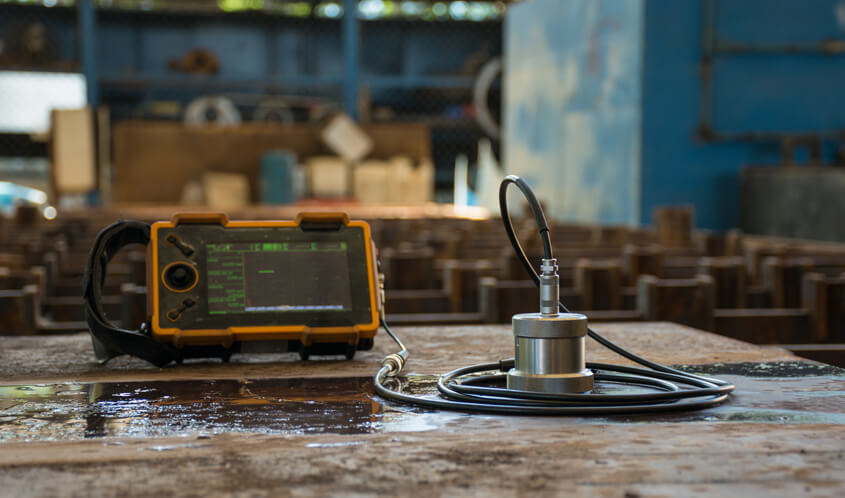Non-destructive testing (NDT) plays a vital role in ensuring safety, quality and reliability across many industries. Within the domain of NDT, ultrasonic testing has emerged as one of the most widely used techniques for detecting flaws and assessing material properties without causing damage.
Working of Ultrasonic Testing Equipment
Ultrasonic testing uses high-frequency sound waves to conduct examinations and is based on the principles of echography. In ultrasonic equipment, piezoelectric transducers are used to generate and receive ultrasound waves. The transducer first converts electrical pulses into ultrasonic compression waves when electricity is applied. These waves travel into the material and interact with any discontinuities, cracks, voids or changes in material density. Some of the ultrasound gets reflected back and is detected by the transducer, which converts it back to electrical signals. By measuring the amplitude and/or travel time of these reflected signals, information about flaws and internal structure can be deduced.
Modern ultrasonic testing systems use computerized pulse-echo and through-transmission setups to examine materials. In pulse-echo mode, a single transducer is used for transmitting and receiving waves in a single material. Through-transmission involves using separate transducers to send and receive waves across a sample, enabling thickness measurements. By scanning the probe over the surface, combined with automated or manual translation mechanisms, entire test regions can be mapped. Digitalization has improved imaging, data storage and repeatability compared to earlier analog equipment.
Common Ultrasonic Equipment Components
All Ultrasonic Non-Destructive Testing Equipment systems incorporate the basic modules:
– Pulser/receivers – Produce high voltage electrical pulses to excite transducers and amplify returning echoes.
– Transducers – Usually made of quartz, LiNbO3 or PZT piezoelectric materials. Come in different configurations like straight beams, angle beams etc as per application.
– Couplant – Substance like water or gel applied between transducer and test part to facilitate wave transmission.
– Cables – Connect transducers to main unit and transmit pulsed signals. High damping coaxial cables used.
– Scanners – Motorized probes for scanning larger areas automatically in pulsed-echo mode.
– Displays – Indicate echo strength and position. Range from simple LEDs to advanced LCD/Cathode ray screens.
– Probes – Houses transducer and focuses ultrasonic energy. Available as immersion, contact or angle probes.
– Recorders – Preserve C-scan and thickness mapping data in electronic/printed format.
– Software – For automated flaw detection, precision thickness measurement, and data analysis.
Applications of Ultrasonic Equipment
Some common applications where ultrasonic testing is employed are:
Welded Joint Inspection
Weld imperfections like cracks, porosity and lack of fusion are common reasons for failure in pressure vessels, pipelines etc. Ultrasonic pulse-echo technique enables high resolution imaging and flaw detection in welds.
Thick Section Testing
Internal flaws in thick castings, forgings and plates over 50mm can be located using multiple element transducers with deeper penetration. Used in hydroelectric dams, ship hulls etc.
Tube and Pipe Testing
Corrosion, pitting and wall loss affect tube/pipe integrity in heat exchangers, condensers. Internal profiling discovers such defects early without dismantling.
Composite Material Evaluation
Delaminations and voids within composite layup are found by sending shear or longitudinal waves. Used for aerospace components, wind turbine blades etc.
Discontinuity Sizing
Flaw sizing in real-time using electronic calipers allows go/no-go acceptance decisions without removing parts from production.
Modern Trends in Ultrasonic NDT
Advancements in transducer design, electronics and data processing are expanding ultrasonic NDT capabilities:
– Phased array techniques electronically steer and focus beams for rapid inspection of complex geometries. Used in aircraft, ships, power plants.
– Time-of-flight diffraction tomography generates 3D volumetric image inside objects non-destructively. Promising for composite integral structures.
– Guided wave testing employs low-frequency Lamb waves that travel along plate/ pipe surfaces for long-range inspection. Effective for process plant pipelines.
– Integrated digital UT combines pulsing, scanning, flaw detection and data storage in portable field instruments for better site mobility.
– Acoustic microscopy provides resolution down to 1-micron level by suspending transducers very close to surface using mechatronics. Finds nano-inclusions.
– Deep learning algorithms are enhancing C-scan interpretation, flaw classification, corrosion/damage mapping from large ultrasonic datasets.
*Note:
1. Source: Coherent Market Insights, Public sources, Desk research
2. We have leveraged AI tools to mine information and compile it



